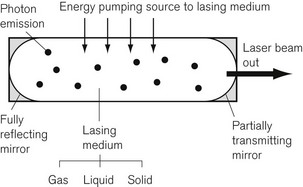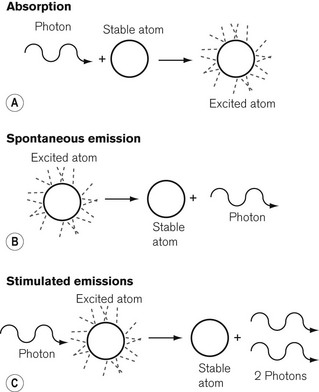Chapter 26 Lasers
Principles
The increasing surgical use of lasers, with their inherent potential hazards to patients and operating room staff, mandates an understanding of their physical principles by anaesthetists.1
Although there are many more complex laser systems,2 the basic components of a laser are shown in Fig. 26.1. The lasing medium may be a solid, liquid or gas. The atoms of a lasing medium are excited to high energy levels by a ‘pumping’ source, which may be a high-voltage discharge in the case of a gas, an intense flash of light from a flashtube or the energy from a radio frequency power source. Fig. 26.2 shows the excitation and emission process possible in a gaseous lasing medium. A photon of energy from the pumping source may be absorbed by a stable atom in its so called ‘ground state’, which then becomes an atom in an excited state, with an electron or electrons in an orbital shell at a higher energy level. Spontaneous emission of a photon of energy occurs as the electrons fall back to shells of a lower energy state and the excited atom reverts to the ground state.
If a further photon of pumping energy, at the correct wavelength, is applied to an atom in its excited state, it will fall to its ground state and two photons of energy will be emitted instead of one. This is known as stimulated emission, originally described by Einstein in 1917 as the basis for laser technology3 and the inversion of the energy states is referred to as population inversion. The emitted photons thus produced are in phase with, have the same polarization, and travel in the same direction, as the stimulating radiation. This mechanism is amplified by many of the escaping photons being reflected back into the lasing medium by the mirrors. Thus a chain reaction occurs, and this can be thought of as a positive feedback system. The process produces an intense source of light energy, some of which is allowed to escape through the partially reflecting mirror at the output end of the lasing medium. The output beam of the laser is usually directed to the tissues through a fibre-optic light guide. However, the wavelength of the carbon dioxide laser is so long, at 10.6 µm, that there is no fibre currently available to transmit energy, so that it has to be directed by a series of mirrors instead.
Clinical applications
The clinical use of lasers depends on a compromise between:
The extent of the effect of a laser on human tissues depends primarily on the intensity and the frequency of the light being used.5

Full access? Get Clinical Tree










